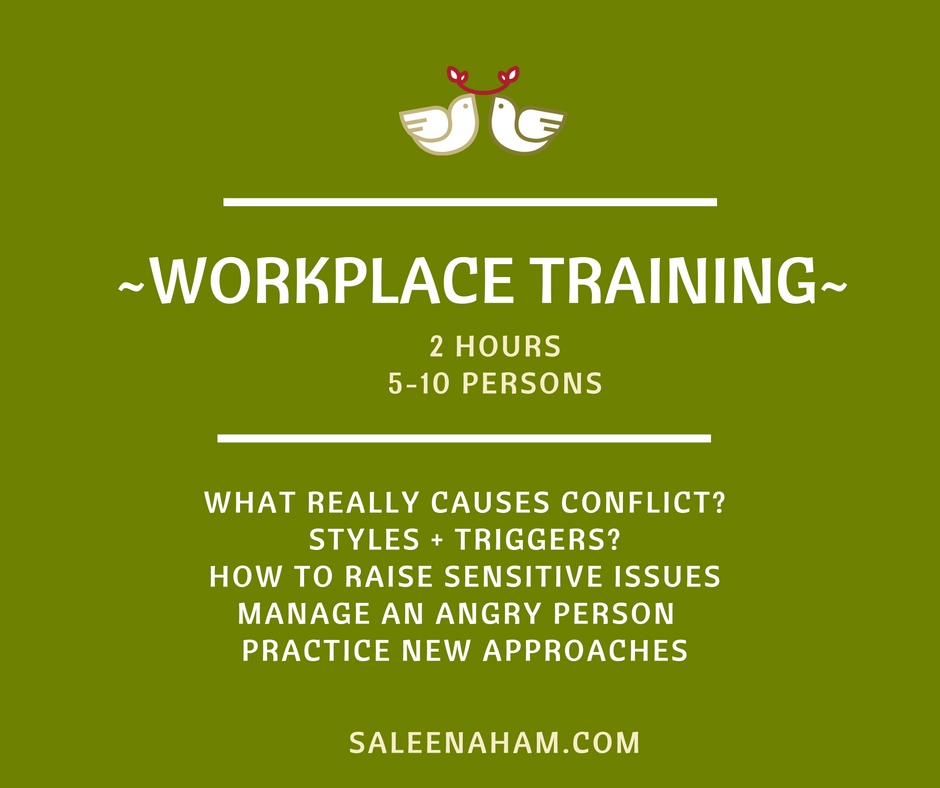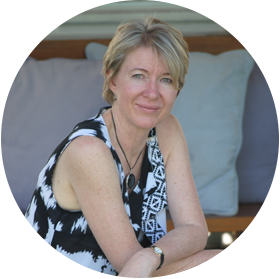Conflict unleashed seems to be in every headline. It makes people uneasy, on guard, defensive. This increases sensitivity. We are more alert and ready to see danger and offence where it does not exist. And in responding to feared but not-real threat we create conflict. Let’s unpack a case study showing exactly that and what we can do to be a positive influence.
Following the election of a new US President, an immediate rise in reported attack and abuse against non-white people in the United States is gaining attention and raising community levels of fear.
Violence, direct (abuse and assault) and indirect (graffiti, overt discrimination) is creating fear, anxiety and resentment.
This environment and experience creates a certain energy that makes people more on guard for attack.
Here is an example of how that can play out.
In a line of conversation in an online group a man posted this photo as a comment on the post-USA election.
And received a response.
A classic example of misperceptions, of an expression being taken as a source of threat and hurt.
What can be learned here?
Observations, positions, opinions made from one viewpoint or experience have been read and received by an Other as offensive.
This happens so often. We are all guilty of it. We have all experienced it.
Some action, statement or a representation is taken as personal attack or threat to Me. And so I respond, fast and without reflection, on the rush of uprising emotion. Anger.
Triggered, I defend or attack, without reflection or enquiry.
And then, I have created a new situation. Now there are further issues of shame and saving face. Of hurt and the need for sticking with the battle, of further attack and defence.
Or if I can’t cope with the battle now created, I run away.
My Anger unresolved, grows and moves to other things.
I have taken your comments or actions as a personal threat and I see You as the problem.
Not the offending action, statement or representation. The offence is a threat and it’s attached to You.
My focus is not on my Self and what is really driving this rising sense of fear. Nor am I questioning whether this is really attached to or caused by you. Nor is it on any action that might reveal or fix that. In my mind it’s You. You are the problem!!
Most confidently I can say that a counter-response of anger is unlikely to solve or resolve my unseen, underlying driving needs.
So, I tell you exactly what I think of you, personally, or take action if I feel that I have the power or permission to do so. Or lack control to stop myself.
I will take action. If it is not safe to take that action, I will suppress my anger. Hide it. Even from my Self, sometimes. Or I will run away.
But unexpressed Anger never goes away.
It emerges in ways I may not even recognise as sarcasm, antagonistic behaviour, snarky side comments, white-anting or obstruction. Sneaky violence. Bitchiness. Prickly attitude.
It sits, underneath, chewing emotional energy, causing stress, illness, relationship damage, bubbling away and prompting all sorts of unhelpful behaviours until it has its moment of recognition and expression.
The response of Anger easily flows from one source – where it is unsafe to express it – to another innocent one – where it is felt to be safe to express it. Anger flows and grows.
As does grace and kindness.
There is some Truth in everything
One incident. Multiple stories. Each story is not wrong. It is not understood.
Look for the Truth in the Other perspective. A different lived experience, a strong felt emotion.
The example of the conversation in the thread above is an example of misunderstanding and action taken on that perception, to stay ok.
It was interpreted as an attack on/denial of a person’s reality. While at one level the meme was true, at another it was frighteningly untrue.
The meme was a symbol, for one party, of a privileged group being disconnected with the lived reality of the oppressed and it was called out as a naive and patronising response to – or was it a rejection of – another’s feared or felt reality.
A bit like Marie Antoinette saying “Let them eat cake.” Inflammatory for the hurting, angry mobs. A symbol of disconnection from the lived reality of the people. But not said with any actual malice by the Queen.
The author’s intention for the meme might be a reassurance that underneath the chaos, the things that matter and unite us are still there.
A bit Buddhist. A bit Christ-like. Remember that these things too will pass. Not a denial of anything. A reminder of underlying foundations of faith and internal peace-centred living.
For one party the intended interpretation of the image is a message of spiritual connection, assurance that all that really matters is untouched, that all will be well.
For another, it might be interpreted as a statement: “I was ok before, nothing has changed for me (the privileged) and I am still ok.” Other Stories are also possible.
Or it may be a trigger that sets off reminders of awful lived experiences where bad things happened that could not be controlled, expressed or acknowledged. No one came when I needed help. And it’s happening again.
In the context of our present historical moment, the post above taps a deeper set of symbols and stories, including a story of perceived endorsement of racial oppression and frightening values and a story of justified rejection of elite hypocrisy and disconnection.
Rejection, isolation, denial of worth, desire for accountability. These things are loaded with so much more than a change of government. There is for some, many, a sense of existential threat.
A different experience, a different language, a different perspective arising from fears that are nothing to do with the person posting the picture actually, but which now triggered are expressed aggressively, hurtfully and personally.
The pattern of conflict unleashed
I can take outward expressions directed at Me personally without recognising that they are really a Red Flag for something else, underneath that is not actually about Me.
Action, inaction, comments or silence, my appearance – become the trigger for an Other person’s fears.
Suddenly, in the space of being under attack, if I feel I am not in a safe place: fight? Take flight? Freeze?
I respond to a sense of threat. It may be actual violence, damage or hurt or it may be my ideas, my own Story being ‘contradicted’ or countered. It still feels like violence, against my Self.
Regardless, we respond to perceived “attack”. Emotions rise.
The damage from responding in kind to the expression of an Other’s fear and anger is real and immediate. And contagious.
Fears are sneaky, powerful hidden drivers for behaviour. When we don’t have awareness of them we direct them onto some other target, some safe target.
This sets off more trouble – a conflict pattern that becomes entrenched and develops layers and history that is very hard to unpack and heal.
Whether in a personal context or a community context – can we recognise the anger as a red flag for underlying fears that are not about Me or Us, personally. They are a symptom.
People are trying to stay safe. It is such a strong survival instinct that safety for Other loses value to me, if I cannot pull my Self up and work out what is really happening here.
You, the Threat, have to be labelled and become the Other, so I can justify my actions and behaviours in protecting what absolutely cannot be compromised: my deep needs, values and sense of identity.
This observation is not to justify unacceptable damaging anti-social behaviours that have consequences for individuals and communities.
The expression of violent behaviours and attitudes needs to be firmly addressed with consequences and boundaries or it will escalate uncontrolled.
But that alone isn’t enough if we really want to solve the deeper problem and build strong community.
Solving problems when we are afraid
We need to find a way of making visible the underlying drivers for conflict and give them some safe way of being seen, expressed and honoured.
Then they can be really addressed.
If in our unaddressed fear, we keep dealing with the out-workings and not the underlying source, we do not solve the real problem.
This applies to us as individuals in our own conflicts and also as community and nations.
Where-ever we define Us and Them – there is an opportunity for deep listening, respect and willingness to understand what is in this situation for You that I am missing.
A call to overcome fear and visceral emotional response to violent, threatening, frightening triggers and enquire: What are the real drivers for this conflict?
Surface them. Bring them to light. Hear them. Listen for them.
In the case study of the offending meme, this did not happen.
On this matter there was no physical threat but clearly it resulted in some people being hurt.
Instead of sticking it out in the space-of-difference, enquiring to really understand, it was emotionally safer to throw an arrow and run away.
We all suffer when this happens.
How can we make safe space for the views and opinions that we fear to be heard, to be recognised? It’s not necessarily easy.
How can we safely search for understanding when the threat of violence is real? It’s not necessarily safe.
We must be pragmatic in what’s real experience and we must protect safety. We must be idealistic in intention and inclusive of all views. Both together, at the same time.
Don’t catch the arrows. Let them fly by. Don’t chase the arrows. Look to where they came from – what is the bow. Address the energy of the bow.
Enquire. Explore. Engage. Be willing.
It’s not enough for just one party to be open to this courage and curiosity, to seek understanding but it is a start.
And someone must start. Someone must model the values we want.
While drawing boundaries on unacceptable actions, can we deeply listen – not to the overt expression of hateful rage and abuse, of violence in one form or another – but for what lies beneath, the underlying fear that demands expression and action.
This is our challenge.
Saleena
PS – My love is to help people get to better working relationship by building their own awareness, skill and confidence in solving problems where we don’t agree.









